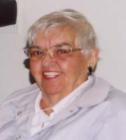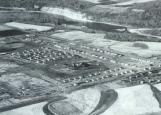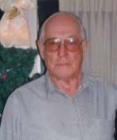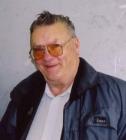1
Some "socialized in some of the finest hotels with fellow swampers and lunched on bush trails with C.E.O.s", while others fought wild wells, and others bought and sold million dollar companies. They represent great diversity.They are Alberta's Black Gold Pioneers.
3
Lois ArgueEdmonton, Alberta
My first encounter with Imperial Oil was in Regina,Saskatchewan, as Mr. K.C. Crook and his large family were family friends and we visited back and forth continually. Mr. Crook was the Manager of the Imperial Oil Refinery at
the north end of Regina for many years. They later retired in Vancouver, B.C.
One summer’s day back in 1924-25, I
climbed to the top of one of the big, white oil tanks, and my mother was a little concerned when she saw me up there, but I had just followed the other Crook children. Today,
when I drive by those tanks, they bring back many memories.
During the Second World War in Edmonton, Alberta there were gasoline tanks everywhere filling up trucks and planes.This was done by the civilian girls on the RCAF Stations,and we often played softball while the vehicles were being
filled.
By 1945, thousands of men and women were discharged from the Services and scrambling for jobs. Many were desperately trying to attend the University of Alberta and were registering in Engineering, and they soon became interested
in obtaining a job in the Oil Fields, and with the many huge Oil Companies like Gulf, Texaco, Shell and Imperial as oil had just been discovered in the fields at Leduc and Devon,
and had been well established for many years in the Turner Valley area with big Oil Company offices both in Edmonton and Calgary, Alberta so it was only natural they hoped for a job of some kind in the oil fields.
At the time, I was in charge of all the registration,
records and examinations, assessing fees and Convocation at the University and every spring the top brass of all these Oil Companies would be sitting in the Registrar’s office where I worked, waiting for the student’s examination
results and announcing scholarships to the honor students.
All year the students had been gaining experience in the oil fields at Devon and Leduc too, so there was a very close connection between the office I was in and the oil fields.
In 1947, when oil was discovered at Leduc #1- Edmonton had a population of only 91,000 and its boundaries were more or less 116 St on the west (124th Street was there but rather
dormant), Kingsway Avenue on the north, 103rd Street on the east but only as a dirt road and 81st Avenue on the south….
So actually all the oil activity with the many new vehicles,both cars and trucks, was along 104th Street on the Southside, and on Jasper Avenue in the downtown area as well as 101 Street.
Unless you were in the oil business and buying fleets of vehicles no one owned a car, nor were they available to buy. Everyone rode a streetcar, so all in all it was a very cozy situation and we got to know most everyone very quickly. It
was not until 1950, that I went to Windsor, Ontario to buy my first car and drive it back to Edmonton having gone down on the train to pick it up.
So everyone was very aware, that it was chiefly the Oil Companies that owned most of the
cars that were driving around the City of Edmonton in those days.
Then overnight, when oil was discovered, it seemed the whole area came alive far faster than in Klondike Days. Oil Companies from the United States and the Turner Valley/Calgary areas moved in very quickly, and there were all
these beautiful company cars, very large trucks and other equipment on low-boys, and seismograph vehicles- something
we had never seen previously. Companies like Halliburton- with their dark red colors; Schlumberger of Canada with their blue colors (later predominantly white); B.A. Oils
with their familiar green and red and white colors and Imperial Oil, who always claimed they had the best piping. They were individually wrapped in yellow paper of some sorts and stacked very neatly and tied securely. Actually you could tell the difference on the trucks.
Construction companies sprung up quickly and other trucking companies that did all types of work in the oilfields. Things had been so quiet right after the war, and men and women discharged from the different services wondered and worried about what they were going to do with the rest of their lives, and then oil was discovered and everyone wished
they were trained to do a job with the oil companies then, so there was a great rush to quickly establish themselves and they were all hoping they would be hired into a good
job. After receiving $30.00 a month in the service, $350.00 in the oil field made you feel like a millionaire! Portable offices sprang up everywhere and such companies as ATCO did
a big business. Imperial Oil had a very small building on the corner of 51st Avenue and 103rd Street in Edmonton, about the size of a farm granary or half an old barracks. I
applied for a job there at $365.00 a month that sounded unbelievable but I had already accepted a job at the University of Alberta for $50.00 a month. As I had made a
commitment at the University, as it was the honorable thing to do in those days, I did not break the commitment and it is just as well I stayed at the University as it turned out
to be far more secure and the pension was good….
James & Reimer Trucking Company was one of the companies, and over the years I knew many of their drivers at Leduc. They drove all over the province. One night a load of pipe from one of their trucks crashed through the cab as it went into the ditch by Strome or Hardisty, Alberta, and although the driver was not hurt, he was certainly shaken up, and he had no way to get back to Leduc, so I was called in the middle of the night to pick him up.
I was often called in the night to act as the “Pilot Car” when dangerous goods trucks were being transported through the City of Edmonton long before there were official pilot cars who received big money for the job…I use to do it by my generous nature without pay.
In the days of the booming oil, there were no sleeper trucks, and drivers and swampers stayed in old hotels, often sleeping on the floors. They had none of the conveniences
in their trucks that they have today, or in living
conditions. Mobile homes were very primitive even if it meant their wives and families could be with them in the oilfield. I remember one group NE of Fort St. John, B.C. in the bush.
I also remember many of the wild stories from
those that had to bunk together in the old hotels. It was a hard way to make a dollar, but at least they were on the way to fulfilling their dreams of a wonderful life….
Towns and Oilfields sprung up everywhere in those early days, and those that have been very quiet previous to the discovery of oil came very much alive. Places like Leduc for instance. Who can forget the huge piles of goody mud on its one Main Street. It seemed it was 15 or 20 feet deep as the long truck with pipes hanging out the back ploughed down the center of the street. There was one General Store on Main
Street in Leduc then, and I can still remember the dry mud being dragged into their door as the sidewalks were covered.
Across the back alley from the store was a young couple who painted ALL the signs for every oil well with its name on it, number and name of the company. I should remember their
name as I knew them well, but that is many years ago now, but his wife painted the background white, and her husband
did all the lettering. When you think of that today it truly was remarkable, as there are so many companies doing the same work today, and charges are very high for such work. Those signs were not only all over the Leduc and Devon fields but at Wizard Lake and Golden Spike and away up North. When the couple finished the signs, they make personalized license plates, especially for weddings, and
painted men’s ties with oil scenes. There is a shopping centre now, where their house used to be.
Not only Leduc, Alberta grew and was advertised because of the discovery of oil, but such new areas as Josephbug, where
the families lived in trailers, and it was such a neat little area. I visited there so often, especially in the winter time.
Wizard Lake, was another place in the bush. It certainly was not a resort then, but many plants sprung up in the area. I’ve given all my snapshots of those plants to the archives. The oil opened up the area, and for many years
now there have been many cottages around the shore line, the water skiers at one time tried to claim the area until they finally had to move out.
There was Judy Creek oilfield in the north, and once again we ploughed through the muddy roads to get in there, but they did have a beautiful log building as an office there,
(until) it was carefully moved to Swan Hills, Alberta, where it became their Tourist Bureau complete with plaques on Judy Creek, and it is kept very well supplied with tourist information. Even if you wish to visit the Maritimes, there
is no better place to find it than there at Swan Hills.
Swan Hills was another area that developed due to the discovery of oil. The first time I visited there, there was only one small hotel, and a tiny store and mountains of mud in between the two buildings, so I was pleasantly surprised
to see their paved streets, curbing, beautiful big homes, schools, and businesses when I visited there in 1991.
Golden Spike has always appealed to me for some reason, even the name sounds romantic, and we certainly did not expect to find that in the bush south west of Edmonton. Although I
have been driving through there on my way to Pigeon Lake the past 40 years, it still makes me feel good.
Camrose, Alberta became well known for the valves they invented and manufactured for use in the oilfields.
I remember meeting a man in an oilfield once- he was an inspector or a “spy” for an oil company. He sat in his car with strong binoculars, spying on other oil companies to see
what they were doing. His salarywas$1,000,000 a month, which made him seem like a millionaire in those days, but few would ever want his job. I often felt sorry for all those working at the oil wells in all the mud and grease, and through the hot sunny days, rain and wind and then there
were the long winters… which were so much colder in those days.
Charlie Roberts, who had been in the Dental Corp during WWII, and was stationed with me both in Regina, Saskatchewan and at the Municipal Airport in Edmonton, joined
Schlumberger in 1948. Charlie and his men bought many huge seismograph trucks from their headquarters in Dallas, Texas.
In 1968 I joined their company in Accounts Receivable, and learned much about oilmen when they submitted their travel claims, all about the permit required, and parts for trucks.
Schlumberger became very involved with the oilfields at Zama, High Level, Judy Creek, as well as in the Dawson Creek, B.C. area where they had a big office. I traveled many times to all those areas…. It was a very sad day when
Charlie was killed on duty at the Schlumberger garage in Dawson Creek, B.C. in February, 1972.
…the whole world seem to open up and come alive, when (Leduc) #1 Oilwell blew in south of Devon. When the news spread early that morning, everyone stopped working in their
office to listen on the radio…. The radio announcers in the News Media had never heard of Leduc before, and continued to pronounce it as "Leeduck", which annoyed us, and there were so many stories written in the newspaper that were not correct, expecially by writers in the east who had no idea of the area in the west.
5
Near the oilfields, exising towns grew with the industry and the entirely new town of Devon was built as a home for all the new workers and their families.7
Frank C. BaillargeonBeaumont, Alberta
Born in Edam Saskatchewan, son of farmers, worked on farms to age nineteen, then came to Leduc in October, 1947. We were loking for more permanent work and a better future. Started high rigginf for Hislop Construction, and was on the crew that built the derrick on the site of Atlantic #3, for General Petroleums ltd, we all know what happened at Atlantic #3 the wild well that eventually caught fire.
My next job was with James & Reimer Ltd. based in Leduc. Moving rigs and oilfield equipment, delivered a treater unit to Imperial Red Water #1, helped to move the first rig into Drayton Valley, and delivered equipment to many locations in the Western provinces and North West Territories.
I delivered a load of line pipes to the West relief well location, when Atlantic #3 caught fire, and was on stand by all night.
I left the oilfields in 1956, to sell Motor Trucks for Kenworth Ltd, and then eventually real-estate sales and commercial development in Fort McMurray, Alberta, where oil plays a very strong part in it's development.
I've been retired 13 years, and have taken flight with the snowbirds to Arizona in the winter months and many travels to far away places.
9
Hislop Construction on the move in Leduc County in 1948.11
Percy BeebeEdmonton, Alberta
I was born in 1925 and raised as a farm boy at Monitor, Fort Assinaboine Homestead and Barrhead. I worked briefly for Imperial Oil as a jug hustler. K. Travis and I bought a failing siesmic drill but amalgamated with three Imperial Oil boys in Calgary as the "First all Canadian Siesmograph Company in Canada".
Later started Freelance Well Services Ltd. with Walter Scott, a Turner Valley oil man and contracted to Imperial Oil in Devon area.
Later invested in Canadian Theatres Ltd and Sahara Theatres ltd and lost my shirt when television came in.
I worked as a high rigger on building and water tower maintenance with the Provincial Government from 1955 to 1960.
1960 to 1987 Building and construction superintendent on city Government buildings, until I retired due to asthma.
I still enjoy an outdoor life, travelling, reading and antique cars.
13
Bob CaineNisku, Alberta
I was born in Edmonton, Alberta. A fur rancher. Went east to the Maritimes and Ontario when I was 15 to work on a fruit farm and in the hard rock mines of Northern Ontario. I read about the Leduc Oil strike and came back in early 1948 to join Drilling Contractors Ltd.
I worked on the rigs for 2 and a half years then joined M.O. Johnston Oilfield Services as a tester. A company change to Johnston Testers allowed me to manage the Peace River region for three years before a transfer to Virden to open a division and manage Manitoba and south east Saskatchewan.
I left Johnstons late '56 to build and operate my first motel in Estevan, Saskatchewan. I left the motel in 1960 and returned to Edmonton for one more year with Johnston Testers and Wydrill Diamond Drilling.
I bought the Van Winkle Motel in 1962 and for 25 years resided on site redeveloping it into a 200 room hotel and going to school for eleven years. While we were there, we raised five children and bought purebread cattle farms near the Edmonton International Airport in Leduc County. We sold the hotel in 1986 and have spent the years now raising registered cattle and doing substantial volunteer work in the Leduc region.






